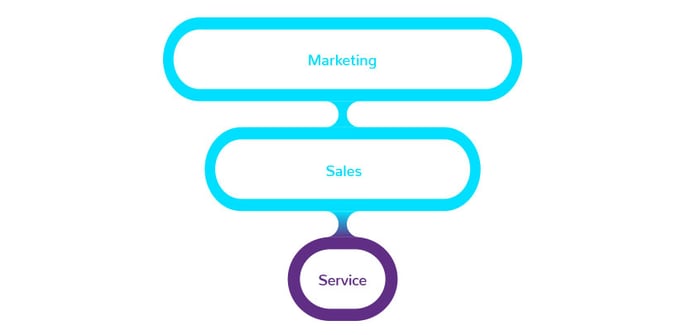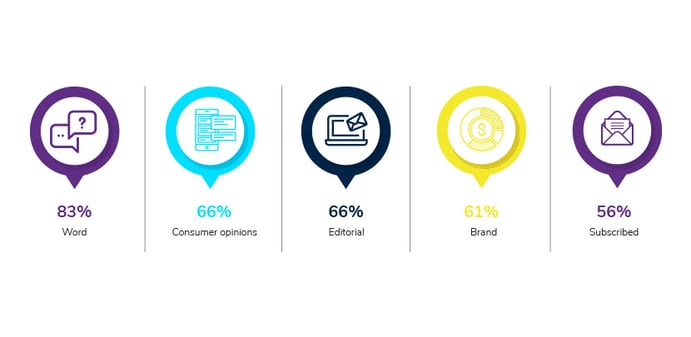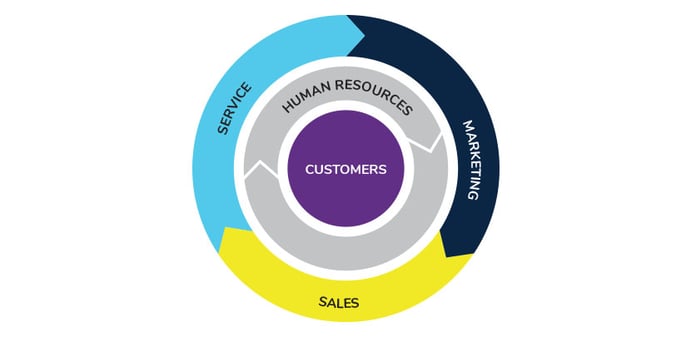In 2013, a study predicted that by the end of 2020, customer experience (CX) would overtake price, product and expertise as the key brand differentiator1. Now, with 2020, the pandemic, the rise of ecommerce, in the rearview mirror, it's become clearer than ever the importance CX has on businesses.
Because brand loyalty rates are falling.2
Today, consumers are less loyal and more likely to switch brands after a poor experience. In a world where consumers can look up product and service reviews at the click of a search button, CX is no longer optional. Businesses that fall behind in this arena stay behind, and those that succeed rely on one thing: strong customer insights.
CX is the key to long-term sustainable growth. Providing a superb, frictionless experience keeps customers coming back and advocating for you. Businesses that lead in CX have a compound average revenue growth rate of 17 per cent3. CX laggards, on the other hand, rarely achieve 3 per cent.
The numbers are telling and people—businesses—are noticing.
CX is the difference between success or slump.
— Chris Pescott, CEO of Perceptive.
What CX laggards have in common is how they view their customer journey. Nine times out of 10, they see it as a linear progression. Problem is, it doesn't represent reality and adhering to this outdated model can lead to less than desirable results: missed growth opportunities, declining advertising performance, long sales cycles and customer churn.
A strong CX, meanwhile, places the needs of the customer at the core of every business function. From marketing and sales to services and operations—the customer is the compass. The destination? A coherent experience across the business.
The first step in this journey is to understand your customer. Yet, many businesses do not know who their customers are or what their experiences look like, much less how to leverage this information to enhance their CX. They lack the key ingredient to CX success: customer insights.
But that’s about to change.
This white paper challenges the traditional view that the transaction is the end-game. Customer-centricity forms the basis of a successful customer experience strategy and, by extension, a successful business. And we’ll show you how.
Short on time? Download this white paper to read offline!
Businesses often have a linear view of the customer journey, usually represented in the shape of a funnel. Unfortunately, this representation doesn’t reflect the reality of how consumers buy. They are smarter, more savvy and far more educated when it comes to purchasing. They expect more than being shoved down a funnel.
Today, customer journeys no longer start at the top of a funnel and move down to a final sale at the bottom.

The traditional, linear view of the customer journey is no longer accurate.
What’s more, the attitude of people who come out of the funnel directly impacts the number of people willing to go in at the top.
The funnel is too simple, too arbitrary and too inaccurate. But even worse, it ignores one of the primary ignition fuels (and outcomes) of customer experience success.
Yes, we’re talking word of mouth.
Suggested reading: Consumer behaviour is changing—and you need to change the way you sell
Word of mouth has undergone a resurgence. It is the single best source4 of new business. Customers have disrupted the roles of salespeople and marketers around the world. In fact, over 80 per cent of consumers believe recommendations from friends and family over all forms of advertising5.
The most trusted ad formats:
 [Source: Neilson, 2015.]
[Source: Neilson, 2015.]
Failing to deliver a superb experience can lead to poor word of mouth, which can impact directly on your bottom line. A subpar CX can cost customers, revenue, and a healthy sales. This is why CX is more important than ever before.
Suggested reading: The top customer experience trends you need to know now
Globally, people are becoming increasingly sceptical of sales and marketing. Consumers see brands as faceless entities, each pursuing their own agenda rather than the needs of the customer. In this era of fake news and misinformation, consumer trust is simply not like it once was. One recent survey6 discovered that only 3 per cent of respondents said they considered marketers to be trustworthy. Hence the revival of word of mouth.
Moreover, the way customers gather information has changed. Today, we’re inundated with marketing messages. So much so that it is difficult (and time consuming) to filter through it all. The result: we shortcut. We turn to friends and family for advice—and that’s changed the paradigm.
Power has shifted to the customer. They can control a company’s brand message as much as marketing or sales—if not more. It stands to reason then that meeting customer needs and providing a positive brand-customer interaction is paramount. Yet, the traditional conversion funnel falls short in this regard. It’s still firmly fixed on driving a prospect toward a company’s goal: the sale, never mind what the customer wants.
Reliance on this outdated model can lead to a misalignment between what your business believes they deliver and what the customer actually experiences. Bain&Co7 discovered that 80 per cent of businesses say they deliver a ‘superior’ customer experience. However, only 8 per cent of people think that these same companies actually do deliver a ‘superior’ experience.
When this misalignment delivers a negative experience, over 40 per cent of customers will take to social media to vent8. Consider that the average Facebook user has 155 friends9, and it’s easy to see how quickly negative word of mouth can spread.
The lesson: experience matters.
Suggested reading: 5 leadership strategies to drive business growth with customer experience
Flywheels helped usher in the industrial revolution and the space age, and now they’re changing the way we think about business.
Their principle is simple: external forces turn a disc on an axis, causing it to spin. As the disc rotates, it stores and builds energy. The more energy it receives, the faster it spins—like the wheel of a bike.
Marketing, sales and service are the core functions of a business, they are as crucial to your business as your employees. Without your employees or these core functions, you can’t attract, engage or delight customers. For a customer-centric business, it follows that all functions must orientate to customer needs.
The customer, therefore, is your growth axis.

The CX flywheel harnesses positive customer experiences to drive sustainable growth. [Adapted from HubSpot, 2018.]
Each component of the flywheel is responsible for enriching the overall customer journey. They are what powers and spins the CX flywheel.
When marketing, sales, service and human resources are in sync with each other, the energy your flywheel generates builds. The result is a seamless experience as the customer travels from pre-purchase to post-purchase and back again.
The best experiences—the ones with the most energy—often see customers re-entering the cycle with the intent to purchase again. They’ll buy more, promote your brand, and recommend you to others, all of which increases the momentum—and mass—of your CX flywheel.
Unlike the traditional funnel, where the only way to maintain growth is to pour new leads into the top, the CX flywheel harnesses momentum from the positive experiences of current customers across the entire customer journey.
| Funnel | CX Flywheel |
|
Linear customer experience strategy. Top heavy. Businesses invest all their energy into attracting and acquiring customers, rather than retaining and capitalising on existing evangelists. Short-sighted, view of customer journey. Transactions are one-off goal or output. Conversion focus. Creates a misalignment between marketing, sales, service and HR. |
Holistic customer experience strategy. Energy is spent delighting customers across marketing, sales, service and HR. Long-term, view of customer journey. Customers are a source of continued growth. Relationship focus. Creates alignment between marketing, sales, service and HR. |
Suggested reading: How digital innovation trends impact customer experience
The better the customer experience at each stage of their journey, the more energy is applied to the CX flywheel. From a business perspective, the faster the CX flywheel spins, the faster a business grows.
Takeaway: everything a business does should be done with the goal of creating world-class customer experiences that add energy to the flywheel and accelerate a company’s growth.
Investments across marketing, sales, service and human resource (HR) focused on improving CX will exert a positive force on your flywheel. However, you cannot simply focus on one area. Forces must be applied holistically so as not to cancel each other out. This means aligning your teams so everyone is on the same page and working toward the same goal.
Forgoing one area can degrade your whole brand experience.
— Sammie Parkinson, CX Team Lead, Perceptive.
However, this is often the biggest challenge.
Broadly, the symptoms of misalignment can include long decision-making processes, infrequent communication, lack of clarity and responsibility, as well as tension between teams and finger pointing when opportunities fall through or customers churn. This all comes back to employees, which is why HR is such an important component of the CX flywheel (and any customer experience strategy).
On a more granular level, companies may also experience symptoms specific to a misalignment between sales and marketing, sales and service, or marketing and service.
Unproductive prospecting. Sales are given unreceptive or misinformed leads from marketing, or not enough leads to maintain a healthy sales pipeline.
Poor management of opportunities/missed opportunities. Marketing provides strong leads to sales that are not followed up on.
Ineffective sales enablement content. Approximately 65 per cent of marketing-produced content goes unused by sales10. This indicates that some marketing teams may not have the resources needed to create the type of content sales teams need and the information their customers want.
The closer the link between sales and marketing, and the less friction there is for the customer, the better their overall experience.
— Chris Pescott, CEO, Perceptive.
If you’re experiencing any of these symptoms, it may be a sign that you need to work on aligning your internal departments, starting with employee engagement levels and introducing service level agreements (SLA) to help define service expectations between departments.
Customer friction is a growth killer. Anything that detracts from customer experience creates friction and slows the CX flywheel—no matter how much force you apply.
Friction is anything that:
Common examples include long call holding times, lack of clear pricing, clunky or “buggy” user interfaces (apps, websites, online purchasing), apathetic employees, and insufficient stock (a company doesn’t have what you want, or in your size).
There may be other factors going on in a business that can impact on its ability to provide a superb and seamless experience. While these issues might not affect a customer directly, consumers will nonetheless feel their impact.
The most common ones are:
Legacy systems. Keeping old technology systems and broken processes in place may mean your staff spend more time working around these systems than on the customer.
Wrong resource for the job. This could take the form of lack of expertise or talent, or poorly implemented systems that aren’t compatible with a customer-focused business.
Not enough resources. Sometimes you simply don’t have enough people or the equipment required to meet customer expectations.
Wrong KPIs. People work towards the KPIs they are set. If your business goals and targets are purely financial, for example, people will prioritise those over customer experience. Every good business strategy has customer-centric KPIs at its foundation.
Lack of knowledge. While many businesses know CX is important and want to change, sometimes it’s a lack of knowledge that’s holding their business back from providing a better experience—or simply where to start.
The key to powering the flywheel and aligning your business to the customer is to have an intimate understanding of who your customers are. Equipping your business (and employees) with the knowledge of what your customers want and need, and what their journey looks like, will allow you to develop powerful CX strategies that exert positive force and eliminate friction.
When this happens, your flywheel will:
Increase in size. A businesses that invests in a multi-dimensional customer experience strategy will delight more of their fan base, increase word of mouth, and attract more customers. Having more customers increases the size of the flywheel. This creates mass. The greater the mass, the greater the energy it produces when spun. Customers buy again. Word of mouth spreads, drawing in more customers.
Increase in density. When you understand your customers’ needs and expectations, it becomes easier for a business to deepen their relationships with customers. It creates an opportunity to diversify offerings to include additional products and services, which increases the density of the flywheel. Again, it’s all about building mass. More mass, more energy. With each superb interaction a customer has with your company—the more you delight them—the more likely they’ll return and grow their lifetime value as a customer.
Short on time? Download this white paper to read offline!

Right place, right time, right message: you may have heard this marketing adage before, but what about right person? This is where many marketers fall short.
Getting your message in front of the right person requires an ever-evolving understanding of who your customer is. Wasted ad spend, high bounce rates, poor quality leads are just some of the symptoms of a lack of customer understanding.
Successful marketing requires businesses to have an intimate understanding of their customers. What’s more, customers expect it. And with the wealth of customer data both online and offline at our fingertips, there is now no excuse for businesses not to.
— Oliver Allen, Head of Research, Perceptive.
By focusing on CX, you can build a company that fosters strong market share and customer retention; where you don’t just target everyone hoping for a lucky hit, but strategically target at those who would benefit most from your offerings.
Suggested reading: Creating meaningful customer experiences through content marketing
Failing to place the customer’s needs at the heart of your marketing strategy can lead to a number of jarring experiences that ultimately wear down a customer’s willingness to not only do business with you, but to engage with and advocate your brand.
Some of the most common causes of friction we see:
Interruptive advertising. Today’s connected customer has completely redefined the relationship between brands and consumers. Not only are people exposed to multiple digital and physical touchpoints during their path-to-purchase, they expect seamless transitions at every point along their journey. Generic advertising strategies no longer have the clout they once did. It’s frustrating for the customer, and detracts from their experience with your brand.
Irrelevant advertising. Following on from the point above, exposure to irrelevant brand messaging/advertising can also degrade a customer’s experience of your brand. Customers are exposed to as many as 5,000 ads per day11. If your advertising and messaging isn’t relevant, it gets ignored or, worse still, labelled as spam.
Poor communications. This includes inconsistent, sporadic and/or unrelated communications that leave customers wondering, ‘why was this sent to me?’
Lack of personalisation. It’s no longer enough to provide a better experience than your competitors; the CX leaders of the world have lifted the standard. A personalised, seamless experience is now an expectation—no matter the industry. Customers want experiences tailored to their needs and interests. Fail to provide this, and they’ll switch off, or switch brands.
Suggested reading: The beauty of customer experience automation—go digital or go home
Just as there are sources of customer friction that can drag on the flywheel, some internal elements can also hamper your marketing team’s ability to provide that world-class experience that customers now expect.
Lack of information: Without proper customer understanding, it's difficult for marketers to connect with customers effectively. It equates to a lack of knowledge on how to take advantage of customer behaviours or how to influence them.
Too much information: Today we have access to more customer data than ever before, but this data is fragmented and fractured. Businesses who do not have the right platforms to draw this information together will struggle to uncover meaning in the mayhem.
Poor transparency and ROI: You don’t know what you don’t know. If marketers cannot measure how effective their marketing is, or whether they are passing on qualified leads, it is difficult to grow and improve in these areas.
Poor systems and processes: From a systems side, a lack of tracking means marketers have no visibility over what is performing well and what isn’t. On the processes side, when sales and marketing operate in silos teams, it often results in mismatched expectations and miscommunication; internally between the teams and externally with the customer. This can lead to confusion and frustration on both sides.
Poor KPIs: Often there is internal pressure on marketing teams to justify spend or to produce better or more leads for sales teams. This can cause marketing teams to prioritise the wrong KPIs and lose focus on the customer.
Creating buyer personas to represent your target customers will help focus your marketing efforts, allow you to hone your messaging and spend your advertising dollars effectively. Moreover, it will also help your sales team refine who and how they approach prospects. Start by talking to your current customers.
Recommended reading: Understanding your audience
By 2020, 80 per cent12 of the buying process will occur without any direct human-to-human interaction. The most successful brands—the Amazons and Apples of the world—continually optimise each stage of their customer journey so that it is tailored to their needs.
A customer journey map gives insight into what customers are thinking at each particular touch point. It allows businesses to start predicting how customers are going to behave and helps them find ways to interact meaningfully with those customers.
To do this, businesses need to have a solid understanding of their customers’ needs, attitudes, purchase decisions and online behaviours.
This allows marketing teams to:
Centralising your data in one place creates a single source of truth that your business can share across its different departments. This helps create a unified view of a customer across your teams, rather than a siloed view based just on one team’s data. This can:
Tip: A service level agreement (SLA) between marketing and sales can also help address communication issues between your marketing, sales and service teams.
New platforms come online every day, established ones are improved and refined—all to make your life, and the life of your customer, easier.
For example, using technology we are able to combine multiple offline and online datasets into a single source of truth for engagement. Not only are the implications for advertising return on investment significant, the powerful new dimension this adds to consumer research is enabling smarter marketing, product and business decisions.
At Perceptive, we use technology to reduce customer friction. By combining traditional market research with social listening, sentiment analysis and digital behavioural tracking we are:
Content generated from your customers is more valuable than curated blog content. Having resources, such as case studies and testimonials, all go towards generating positive word of mouth—the single best source of new business referrals.
If you have them, make use of them. If you don’t, look to create a library, as they will attract and assure potential customers that your product or service is authentic.
Suggested reading: Thank you. Two magic words for delivering a great customer experience
With Perceptive’s help, TSB bank launched a VOC programme to get the feedback necessary to guide their business direction and strategy.
The insights uncovered have played a major role in the redesign of their website, collateral and how TSB has positioned themselves in the Australian and New Zealand markets.
TSB’s renewed focus on their customers has not only resulted in an increase in their Net Promoter Score (a measure of customer advocacy), but one that has not fallen below +55 since the start of the programme. Considering that the Net Promoter Score benchmark for New Zealand banks is +1613, this is an exceptional result.
The work we have done with Perceptive has contributed greatly towards the bank’s success. It is great to work with such a knowledgeable team that understand the strategic direction we want to head towards as a business.
— Julia Ord, Customer Experience & Insights Manager, TSB Bank.
Suggested reading: The most successful companies have the best CX - coincidence?

Every customer journey is different and the best sales processes recognise this—and should be tailored accordingly.
Failing to align CX and sales is akin to trying to hit a bullseye blindfolded. Without a customer journey, sales teams have no knowledge with which to approach a potential customer. They may wade into the conversation too early, too late or with the wrong information.
An IDC study14 has found that one third of B2B lost deals could have been won if the seller had been better informed and acted with greater client orientation. As for sales teams, 71 per cent of consumer expect them to deliver personalised interactions—that includes knowing their customers, understanding their needs and buying journey, and tailoring their approach to match. Seventy-six per cent get frustrated if this doesn't happen.
Suggested reading: How superior customer experience is linked to higher revenue
We’ve established that listening to customers is key to keeping the flywheel spinning. However, there are also a number of factors that can act as breaks on your wheel. Apply too many and it will come to a grinding halt.
Here are some of the most common sources of customer friction at the sales stage:
Poor communication: This can include salespeople who are slow to resolve customer queries, provide overly-complicated information, or who are simply not well incentivised and do not listen to customers' needs.
Poor processes: For example, systems that make prospects reiterate their situation or have to wait to be called back; complex payment options; limited ways to get in contact (i.e. phone only) or not being able to undertake a trial without speaking to a sales person.
Lack of information: Such as under resourced salespeople who are unable to answer questions; salespeople who are not mindful of where a prospect is on the buyer’s journey and adjusting their approach accordingly.
Lack of relevant use cases: This relates to when salespeople are unable to provide evidence that their company can meet a client’s requirements. It’s a bit like trying to decide on whether to hire a new team member without having any references to check. If sales teams can’t provide this, potential customers may walk away.
Certain factors in a salesperson's job can limit their ability to focus on the customer, which could mean your CX flywheel won’t spin at its full potential. This generally comes down to two factors:
Inefficient sales processes: Symptoms can include transparent sales pipeline; long sales cycles; and too much time spent on admin. In fact, many sales reps spend as much as 66 per cent15 of their time on reporting, admin and CRM-related tasks.
Lack of information: Gaps in prospect information leading to lost opportunities, or a sales approach that doesn’t resonate with a prospect.
Developing personas will help to better align sales and marketing—especially when combined with an SLA between the two divisions. Having a clear idea of who their core customers are, and what their buying journey looks like, allows both sales and marketing to operate from the same page and provide consistent messaging to customers. This will give sales more confidence in opportunities coming through and reduce instances of apathy.
It will also help sales:
Having a unified customer view begins with your data. Centralise it all in one place, using the same system. The best salespeople are those who are aware of what triggered a potential customer to first engage with the brand. A centralised system (HubSpot or Marketo for instance) allows sales teams to view where a prospect is on their journey, including exactly what content they engaged with and to what extent.
This can:
Implement systems that boost the effectiveness of your sales teams, particularly when it comes to administrative work and other non-selling tasks. Most of all, these systems must either form part of a larger, overarching platform for your business or integrate into one.
A fine-tuned system that complements all aspects of your core functions (sales, service, marketing and HR) not only trims the inefficiencies from your processes, but also provides a seamless experience for your customers. The result: happier customers and faster close rates.
At Perceptive, we’re helping our clients use technology to:
A rural industry body that runs a consulting service recently approached Perceptive in the hopes that we could shed more light on why they suffered from low levels of customer advocacy.
We quickly found that only 20 per cent of their customers knew who their main point of contact was. The root of the problem? Customers only had a relationship with the brand and not with their relationship manager.
With this in mind, our team developed and implemented a programme that shifted the customer experience from a relationship with a brand, to a relationship with a person. The number of customers who knew their rep increased from 20 to 65 per cent within just six months.
As a result the organisation’s Net Promoter Score (measure of customer advocacy) has increased significantly. All it took was an understanding of which part of the customer journey needed realignment.
Not everything in the customer journey has an equal effect on your customer experience. Certain touchpoints will have a very small impact. Others a much bigger impact. The key is figuring out what those are.
—Chris Pescott, Chairman, Perceptive.

A customer’s experience doesn’t just end at purchase, which is why poor service leads to high customer churn in the long term. Excellent service on the other hand retains customers and encourages 90 per cent16 of them to spend more.
To provide superior service, businesses need to work with sales and marketing to ensure that the customer moves seamlessly under the service umbrella once they’ve purchased. A large part of that comes down to support—and how your service team provides it.
The best businesses need to deliver personalised, relevant and high-quality service, especially in troubleshooting scenarios. Those that do are in a better position to set their flywheel’s spinning and reap the rewards that follow.
Some of the most common causes of customer friction in this area of the business are:
Lack of troubleshooting support: This includes not being able to self-service and not being able to access support in a way that is convenient for them.
Under-resourced support teams: When support staff don’t know the answer or how to fix a problem.
Long wait times: Customers don’t like waiting. Long wait time on services, whether it is in line at the checkout counter, being put on hold in a call queue or a month-long wait for an appointment or delivery, can grate away any goodwill you’ve earned.
Poor processes: This includes complicated return process, recurring issues with products or services, and having to re-explain issues to multiple support staff.
Suggested reading: The three Cs of customer satisfaction: Consistency, consistency, consistency
On the business side, there are several factors that impact how well your service staff can provide an excellent experience to customers.
These often include:
Cost to provide good service: Top resources and talent are not cheap or easy to come by, so businesses can struggle to provide and equip enough staff to meet customer service expectations.
Lack of transparency: Not knowing what service channels and resolution methods customers prefer can detract from your ability to provide an excellent experience. A lack of transparency on service requests also means you don’t know what triggers a support call. This can cause you to invest blindly in resources, without knowing whether or not they’ll improve your CX.
Pressure to increase retention and reduce churn: In turn, this also puts pressure on sales and marketing to replace churned customers.
Climbing support requests: This could be due to sales or marketing giving customers incorrect information, the results of new systems or updates to your products. This can lead to long wait times for customers.
Lack of support: This can be in the form of policies, procedures and technology to help service staff do their job to the best of their abilities. Without sufficient support, service staff may not give customers the focus they want or need.
A central system, or single source of truth, for your customer data will allow service staff to see the path each customer has taken to purchase. They’ll know who they are, what product(s) they’ve bought, and what, if any, service requests they’ve logged.
Having this information on hand can help:
The right technology and CRM tracking can help you monitor and track service requests and how they are resolved. It will not only help provide transparency to management, but also:
Pinpoint reoccurring support requests: Knowing your most common support requests can help you develop self-help content for your customers. With it, you’ll not just provide a 24/7 self-service option to customers, but also help eliminate a number of recurring support requests, freeing up your resources for the more tricky requests.
Determine areas that customers require more support in: With this, you can develop better training materials, including clear escalation procedures. Staff become better equipped to resolve issues quickly, able to reset expectations and redirect questions onto the right people. On the customer side, this reduces hold times and the perception of unhelpful support staff.
Enhance customer self-help support: For example, if a customer is viewing a FAQs page or an online Knowledge Centre for a long time, a prompt may invite the visitor to live chat or call if they haven't found the answer or solution they are looking for.
We’re helping our clients leverage technology to:
Suggested reading: The ultimate hack to measure customer satisfaction levels fast
Implementing a VOC programme will satisfy customers' need for a feedback mechanism. However, the benefits don’t stop there. It will also help your service teams to:
Measure customer satisfaction and retention: Not only will it guide your service teams to address their strengths and weaknesses, but it allows you to track how effective your CX changes are and grow goodwill with your customers when they see your business responding to their feedback.
Identify ‘at risk customers’: Your unhappiest customers are some of your most valuable when it comes to identifying weaknesses in your CX. What’s more, a quick solution and resolution to the cause of their problem can go a long way, and potentially save a customer from leaving.
Uncover trends to improve CX: With a VOC programme, you can uncover trends that are having a negative impact on your CX and address these.
Minimise churn at the service stage: With your CX problems identified and addressed in your service, post-purchase customer churn should minimise, reducing pressure on sales and marketing to acquire new customers and replace those you’ve lost.
A customer experience strategy powered by customer insights has the power to change an organisation’s service operations for the better.
One Perceptive customer, a globally recognised bank, offers a significant example. HSBC NZ operated on a relationship manager (RM) model, as many service-based companies do. Each RM managed a portfolio of premier clients. In the case of their premier clients, many have complex accounts and high expectations, which requires extra care on the part of the RMs.
Early on in the company’s CX programme, we uncovered that RMs could be quite difficult to get in contact with, often due to the size of their portfolio and its makeup of clients.
As a result, HSBC made a number of significant changes to the structure of their portfolios and transformed their call centre into a central liaison point for clients if their RM was unavailable.

Collecting and actioning feedback is vital to keeping your customers happy across multiple touchpoints. However, it is only one side of the coin. Your employees are the other. And companies cannot afford to ignore the link between employee engagement and customer experience.
From salespeople and front-of-shop service staff who interact with customers on a daily basis, to developers and marketers who may never meet their customers directly—they all have an impact on CX.
To win a customer's loyalty, you need to engage them on an emotional level. And this starts with your employees. Lacklustre employees lead to lacklustre experiences. If your employees are not engaged with your brand, how can your customers ever be? It is the difference between having just another customer, to having an advocate.
The biggest influence on employee engagement: workplace culture.
A positive, aligned workplace that engages staff can experience massive growth and employee engagement gains, as well as an uplift of over 30 per cent in customer satisfaction levels17.
Disengaged employees cause many friction points for customers and it all comes back to one overarching problem: the employees have stopped caring.
Innovation decline: Low staff engagement erodes communication and collaboration between teams, which leaves employees feeling isolated and disinterested in their work. The repercussions? New ideas are stifled and opportunities to make improvements are missed.
Service slumps: Poor employee engagement can see service quality drop and absenteeism rise, leading to resourcing issues. On top of mediocre service, customers may also experience longer waiting times and receive incorrect information. In today’s competitive market, customers will not turn the other cheek. Instead, they’ll take their business somewhere else.
Mistakes: Employees who cease to care lose focus and make mistakes. And mistakes can cost—be it giving out wrong information or mishandling an order. The result? Frustrated and angry customers.
Poor quality products: No matter how experienced your product developers or manufacturers are, if they’re disengaged, they will no longer care about producing their best work. Product quality will drop and with it, customer satisfaction.
Internal dynamics can create frictions that have ramifications across your business, indirectly affecting the customer. Here are a few of the most common:
No purpose: People need to feel they serve a purpose—as though their work matters. Meaningful contribution to the workplace is one of the four key factors of employee satisfaction (see more on this below)18. Without it, employees take less pride in what they do, which can lead to unproductive teams that make mistakes, produce poor quality products and provide poor service.
Sale slumps: Disengaged staff are less productive and in the case of sales, it can lead to empty sales pipelines and low close rates. We don’t need to tell you what impact this can have on bottom-lines.
Absenteeism and turnover: Increased rates of absenteeism and staff turnover across the business will put pressure on the remaining employees. Workloads and work hours will increase and staff may have to cover jobs they’re not trained for, which can lead to further disengagement within the business.
Culture erosion: Disengagement is like a cold; it is infectious and it can erode company cultures. Ignore it at your peril.
Safety issues: Low engagement can also have major ramifications on safety in the workplace. A lack of care can lead to low focus and attention to detail, which can have dangerous consequences.
Suggested reading: 3 key competencies of superior customer experience staff
Much like a Voice of Customer programme, a VOE programme will give you insight into what your employees think and feel about your company.
Similar to NPS, eNPS measures your employees’ willingness to be ambassadors for the company by advocating employment there. Their responses are recorded on the same 0 to 10 scale and then segmented into promoters, passives, and detractors. Additional follow up questions can provide insights that help pinpoint the areas that companies can improve on so they can provide a better place to work as well as better customer experiences in the long term.
A good way to bring customer experience and employee experience onto the same page is to use NPS and eNPS together. This will help you to better pinpoint CX strengths and weaknesses that tie back to employee engagement levels and workplace culture.
For example, if NPS reveals that customers are frustrated by long wait times, and eNPS shows that staff are feeling overworked, it’s a good indication that you may need to allocate more resources to that area. By doing so, you’ll not only improve your CX but also employee sentiment.
Your CX is strongest when everyone is involved, from CEOs to floor staff. This should include setting up relevant, customer-focused KPIs on multiple levels from company to team and even down to the individual (depending on the business).
Building a culture that is focused on doing right by the customer means sharing both positive and negative customer feedback. Departmental and team reporting is essential for this. As an employer, provide your managers with the skill and means to distil results, analyse feedback and report it back to their teams in a meaningful way.
To ensure their customers remained satisfied, Ray White wanted to put solid measures in place to boost employee engagement and performance. This, in turn, would allow their staff to provide the highest service possible.
To achieve this, Perceptive helped Ray White roll out a comprehensive employee reward and recognition programme.
The programme involved:
The reward programme boosted staff engagement across the Ray White network. The certificates now form an important part of a Ray White agent’s marketing collateral and are used to help establish trust and credibility with prospective customers. Meanwhile, feedback on the employee rewards programme has been overwhelmingly positive across the entire organisation and from all staff levels.
Ray White’s employee reward programme has been instrumental to Ray White’s overall NPS success. Since beginning, Ray White’s NPS has grown by over 30 per cent, and now maintains a world-class NPS score between +75 and +79, putting it leagues ahead of the -2 NPS benchmark for New Zealand real estate19.
People today are more informed and less trusting than ever before. With seemingly limitless product and service options at their disposal, and unprecedented clarity into how businesses treat their customers, there is no one single path to purchase.
For this reason, brands will grow and businesses become more profitable only when they let their customers be their compass.
By shifting your mindset to the CX flywheel, you too can celebrate this evolution and unlock future sustainable growth.
One of the most magical components of prioritising CX is that there is virtually no part of your business that is not impacted. Shifting your mindset to that of "customer first" affects everything you do, from the products you sell to the finance team and the staff you hire. Collecting and acting on customer feedback has a unique way of realigning your business, and in doing so, transforming your approach to each business function, department and discipline.
—Tomas Dickson, CX Director, Perceptive.
Learn how to use customers as your growth compass, eliminate customer friction and align your marketing, sales, services and HR teams for customer success.
1. Salesforce, 2018. 2. Forbes, 2023. 3. Forrester, 2016. 4. HubSpot, 2022. 5. Nielsen, 2015. 6. HubSpot, 2022. 7. Bain&Co, 2005. 8. NewVoice Media, 2016. 9. Omnicore, 2018. 10. Forrester, 2016. 11. CBS News, 2006. 12. Gartner, 2011. 13. As at October 2018. 14. IDC, 2009. 2017. 15. HubSpot, 2018. 2023. 16. HubSpot, 2022. 17. Forbes, 2017. 18. Gallup. 19. As of August 2018.